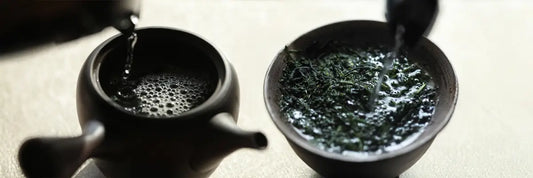Gyokuro plant production starts with the gyokuro plant. 🌱
In this article, we are going to discuss what the gyokuro plant is, how it is cultivated and how it is turned into delicious gyokuro tea.
We’ll also share the story of Mr. Sakamoto, a talented tea farmer in southern Japan, and how he grows strong and flavorful gyokuro plants without the use of pesticides or chemicals.
Let’s dive right into the world of gyokuro! 🍃🍵
All you need to know about the Gyokuro Plant
What is the Gyokuro Plant?

The gyokuro plant refers to the tea plant used to make gyokuro tea.
Although it is the exact same plant used to make other types of tea, it is cultivated in a specific way to improve the flavor.
Later on we will discuss what steps are taken by the farmer to turn the tea plant into the gyokuro plant.
Before you continue, you may want to refresh your knowledge about what Gyokuro tea is.
We strongly recommend you read the article 👉 Everything You Need to Know About Gyokuro Tea. It's the ultimate guide to this magical tea!
Cultivation of Gyokuro Plant
In order to be considered a gyokuro green tea, it has to be shaded for around 3 weeks prior to harvest.
When the gyokuro plant is cut off from sunlight, it forces the plant to produce more chlorophyll to compensate for the loss of sun energy.
The gyokuro plant also produces more theanine and caffeine as a defense mechanism. The caffeine on the outside of the leaf is bitter and even lethal to insects, so the gyokuro plant uses it as a defense mechanism. Because the shading is such a stressful time for the gyokuro plant, it needs to produce even more caffeine to ward off the insects.
After a week or so with very little sun, the gyokuro plant begins to struggle. It is hard to support plant growth in such little sunlight.
What most farmers do at this stage is apply plenty of chemical fertilizers to the crop in order to compensate.
This is not an option for many organic farmers, so it is hard to keep the plant alive using strictly organic methods.
Harvesting of Gyokuro

The Importance of Shading Before Harvest
The harvesting of the gyokuro plant is similar to other plants used to make high-quality green tea. After the gyokuro plant has been shaded for 3 weeks, the top 3 sprouts are selected and gathered up to be processed. The top three sprouts of the tea plant are the youngest and the richest in nutrients.
Why Gyokuro Has High Caffeine Content
These young leaves are also the highest in caffeine, and this is one of the many factors that contributes to the extremely high caffeine content of gyokuro. The reason the younger leaves of the gyokuro plant contain more caffeine than the mature leaves is because they are more vulnerable to insects. Caffeine is produced by the tea plant as a defense mechanism to protect against insects.
Young vs Mature Leaves in Japanese Green Tea
The younger sprouts of the tea plant are more tender, and therefore they need to produce more caffeine than the older, tougher tea leaves. This is why teas made from younger leaves like gyokuro and ceremonial matcha tend to be higher in caffeine than teas made from older leaves like bancha, hojicha and genmaicha.
What difference does shading the Gyokuro Plant make?

When the gyokuro plant is exposed to sunlight, it begins to convert the amino acid theanine into catechins.
The catechins are the bitter components of the tea, while theanine is responsible for the sweet and savory flavor.
While the catechins can be helpful for the tea plant as a protection against UV light, it is not a good thing for lovers of sweet tea like gyokuro.
When you cut the tea plant off from sunlight, you prevent this process from happening, allowing the gyokuro plant to produce a higher amount of sweet and savory theanine.
Where is Gyokuro tea produced?
The gyokuro plant can grow in just as many places as a regular tea plant. A lot of premium gyokuro is made from more delicate tea plant varieties like Saemidori and Okumidori. These plants grow best in milder climates, as they are more sensitive to frost. As a result, a farmer may have more success growing gyokuro plants in southern Japan, as the cold is not as much of a concern here. The southern island of Kyushu is also very volcanically active, so a lot of the farmers can benefit from the fertile soils.
Finally, it really takes a talented farmer to grow a gyokuro plant. The 3-week shading process can be a stressful time for the tea plant, and it will need a lot of nourishment to stay strong and healthy during this period.
The Famous Fertilizer of Mr. Sakamoto

How Mr. Sakamoto Keeps Gyokuro Plants Alive Without Sunlight
The legendary farmer Mr. Sakamoto has come up with an ingenious way to keep the gyokuro plant alive for long periods without sunlight.
He produces his own brand of fertilizer that actually strengthens the cellular density of the gyokuro plant.
This allows the plant to not only survive without sunlight, but also survive without soil. Sakamoto often takes trimmings of non-organic gyokuro plants and compares them to his organic crop in a vase.
After just one week, the non-organic gyokuro plants begin to wilt and die, but his plants still look as strong and as healthy as ever.
Why Sakamoto’s Tea Plants Are More Nutritious
Mr. Sakamoto also explains that these plants are denser in nutrients as well. By creating healthier soil, he is able to bring more nutrients to the gyokuro plant and create a delicious and healthy organic beverage.
A Holistic Approach to Tea Farming
Mr. Sakamoto takes a holistic approach to tea cultivation. It’s not just about making the tea plant healthy, it’s also about making the entire ecosystem healthy.
Because he doesn’t use pesticides on the tea plants, the earthworms and small insects are able to move through the soil and really loosen it up.
This looser soil is a good sign for Mr. Sakamoto, as it will allow the roots of the gyokuro plant to penetrate deeper into the ground and absorb more nutrients, leading to a stronger-tasting tea.
Why is gyokuro so expensive

To learn why Gyokuro is so expensive, we advise you to read the article 👉 Why is the Gyokuro Tea Price so High? You can find a quick summary of the content of this article below.
The end result is the highest-quality green tea in Japan. Gyokuro is also called “the Emperor's tea” because it used to be reserved for the emperor due to its superior quality. Gyokuro has a strong sweetness and umami flavor. It also brews a dense, jade-green liquor that is very high in caffeine and theanine.
It is said that gyokuro has more caffeine than coffee if brewed correctly. Even though it has more caffeine than coffee, you might not feel it because the l-theanine in the green tea counteracts some of the negative side effects of caffeine like jitteriness.




